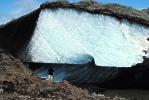 -
- --
--
Yahoo! www.corbis.com/Jim Sugar Photography & www.corbis.com/Bob Rowan; Progressive Image
The Alaska Pipeline
The Alaska pipeline is an engineering phenomena the extends from the oil fields in the northern most portion of the state and winds its way eight hundred miles southward to the port of Valdez. The design considerations encompassed every imaginable obstical from the need for animal crossing to heat expansion rates ranging in air temperature differences of well over 100 ° F. A major consideration in the design of the pipeline was the delicate balance of the vast tundra underlain by permafrost. The sensitivity of permafrost is so great that just one degree of temperature can have longlasting and widespread effect. The control of the heat produced by the pipeline was of major concern.

Natural Resources of Canada
Permafrost is the permanentaly frozen ground found in the northern regions. It is classified by its sensitivity to thaw into two types: cold and warm . The cold permafrost temperature ranges from 30° F down as low as 10° F. This type of permafrost can remain stable with the addition of a considerable amount of heat. Warm permafrost on the other hand does not weather as well. Its temperature is stable just below 32° F, the melting point. Very little heat can effect warm permafrost.
To deal with the permafrost sensitivity many features were designed into the pipeline. Verticle posts were installed in areas sensitive to any changes in temperature. To prevent the thawing of any permafrost the posts contain two pipes each called 'heat pipes'. The heat pipes are condensers filled with ammonia that vaporizes in the ground due to radiant heat and rises to be cooled by the air thus removing the ground heat. Aluminum radiators are mounted on top of the posts to recondense the ammonia.

Alyeska Pipeline Service Company
For the extremely sensitive areas of permafrost that the pipe had to be burried special refrigerator systems were installed. Chilled brine is circulated through the loops of six inch diameter pipe in order to maintain the temperature of the soil and to protect the permafrost.

Alyeska Pipeline Service Company
The above discussion leads to giving thought to thermal gradients. The oil
in the pipeline is at temperatures of 140° F. This is a fair amount above
the annual air temperatures over the course of the pipeline. Could this temperature
gradient potentially be exploited for one of the municipalities that stand
beside the pipeline?
Arctic North Slope Borough - 179.2 mi.
Fairbanks North Star Borough - 89.1 mi.
City of Delta Junction - 5.5 mi.
City of Valdez - 20.8 mi.
Could the pipeline at least help to power one of the ten pump stations located along its winding path?
It is not likely that the heat exchange in either of the two above systems would produce a sufficient enough amount of energy to produce electricity. The temperature of the oil as it is extracted is approximately 160 ° F and the flow temperature approximately 140 ° F. These temperatures need to be maintained for the oil to remain in a viscous enough state to be transport with some amount of efficiency. This inquiry into the potential use of excess heat being produced as a by-product does however open the door to other possibilities.
HOME - INTRODUCTION - OTEC - TURBINE - PIPELINE - BIBLIOGRAPHY